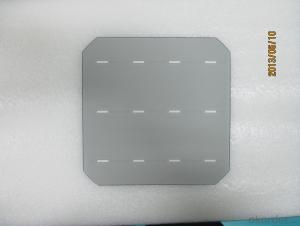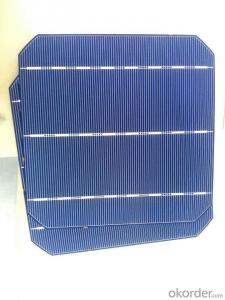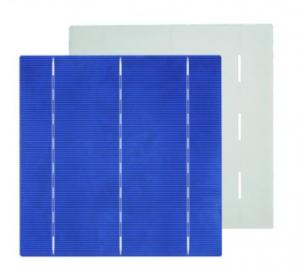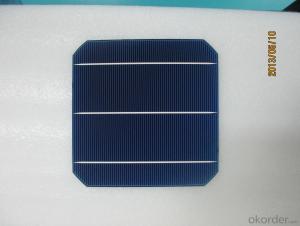Organic Polymer Solar Cells - Monocrystal Solar Energy Cell 156x156mm with 18.4% Efficiency
- Loading Port:
- China main port
- Payment Terms:
- TT or LC
- Min Order Qty:
- 10000 pc
- Supply Capability:
- 1000000 pc/month
OKorder Service Pledge
OKorder Financial Service
You Might Also Like

Monocrystal Solar Energy Cell
type:156M
appearance:156×1565㎜±0.5mm;diagonal:R=100mm
Main fence wide:1.4-1.5mm back electrode wide:2-2.5mm
Fence line qty:90
Cell thickness:220um±20um
Eff(%) | 18.00- 18.10 | 18.10- 18.20 | 18.20- 18.30 | 18.30- 18.40 | 18.40- 18.50 | 18.50- 18.60 | 18.60- 18.70 | 18.70- 18.80 | 18.80- 18.90 | 18.9- 19.0 | 19.1- 19.1 | 19.1- 19.2 |
Pm(W) | 4.30 | 4.33 | 4.35 | 4.37 | 4.40 | 4.42 | 4.44 | 4.47 | 4.49 | 4.52 | 4.54 | 4.56 |
Isc(A) | 8.71 | 8.73 | 8.76 | 8.77 | 8.78 | 8.82 | 8.83 | 8.85 | 8.86 | 8.88 | 8.9 | 8.93 |
Im(A) | 8.19 | 8.21 | 8.24 | 8.26 | 8.30 | 8.33 | 8.35 | 8.39 | 8.42 | 8.45 | 8.47 | 8.51 |
Voc(V) | 0.630 | 0.631 | 0.632 | 0.633 | 0.634 | 0.634 | 0.635 | 0.636 | 0.637 | 0.637 | 0.638 | 0.64 |
Vm(V) | 0.527 | 0.528 | 0.529 | 0.531 | 0.531 | 0.532 | 0.534 | 0.534 | 0.535 | 0.536 | 0.537 | 0.538 |
FF(%) | 78.6 | 78.7 | 78.8 | 79.0 | 79.2 | 79.3 | 79.5 | 79.6 | 79.8 | 80 | 80 | 80 |

remark:our company cells as per working current concentrate principle,separate the first and the second grade
Advantage of Polycrystalline Solar Cells
Tire-1 Solar Cells’ Manufacturer Quality Guarantee. With a complete and sophisticated quality government system, our Quality Management have arrived world’s leading place. Customer can receive Tire-1 Cells Maker’s Quality Standard Products.
Trusted Warranty. We can supply trusted after-sales service to our customer. If our cells are found not in conformity to the specification of manufacturer, or should the inspected quantity found in shortage, or should the packing found damaged, the buyer has the right to claim to the seller. The claim, if any, should be presented to seller within 30 days after cargo's arrival date to the port, together with related inspection report and photos issued and provided by a reputable independent surveyor such as SGS.
Factory Picture of Solar Cells


FAQ
We have organized several common questions for our clients,may help you sincerely:
What’s price per watt?
A: It’s depends on the quantity, delivery date and payment terms of the order. We can talk further about the detail price issue. Our products is high quality with lower price level.
Can you tell me the parameter of your solar cells?
We have different series of cells with different power output, both from c-si to a-si. Please take our specification sheet for your reference.
How do you pack your products?
We have rich experience on how to pack the panels to make sure the safety on shipment when it arrives at the destination.
Can you do OEM for us?
Yes, we can.
How long can we receive the product after purchase?
In the purchase of product within three working days, We will arrange the factory delivery as soon as possible. The perfect time of receiving is related to the state and position of customers. Commonly 7 to 10 working days can be served.
Solar cell power generation system and how its working
Solar panels, also known as modules, contain photovoltaic cells made from silicon that transform incoming sunlight into electricity rather than heat. Solar photovoltaic cells consist of a positive and a negative film of silicon placed under a thin slice of glass and they knock the electrons off the silicon. The negatively-charged free electrons are preferentially attracted to one side of the silicon cell, his current is gathered by wiring the individual solar panels together in series to form a solar photovoltaic array.
The inverter is typically located in an accessible location, as close as practical to the modules. In a residential application, the inverter is often mounted to the exterior sidewall of the home near the electrical main or sub panels. Since inverters make a slight noise, this should be taken into consideration when selecting the location.
In a solar electric system that is also tied to the utility grid, the DC power from the solar array is converted into 120/240 volt AC power and fed directly into the utility power distribution system of the building. The power is “net metered,” which means it reduces demand for power from the utility when the solar array is generating electricity – thus lowering the utility bill. These grid-tied systems automatically shut off if utility power goes offline, protecting workers from power being back fed into the grid during an outage. These types of solar-powered electric systems are known as “on grid” or “battery-less” and make up approximately 98% of the solar power systems being installed today..
- Q: How do solar cells perform in areas with high levels of water pollution?
- Solar cells can experience a decrease in performance in areas with high levels of water pollution due to the reduced sunlight reaching the cells. The pollutants in the water can absorb or scatter sunlight, leading to lower solar panel efficiency and energy output. Additionally, water pollution can also corrode the surface of solar panels, further affecting their performance. Therefore, regular maintenance and cleaning of solar panels are crucial in such areas to ensure optimal functioning.
- Q: How long does it take to install solar cells on a rooftop?
- The time required to install solar cells on a rooftop can vary depending on various factors such as the size of the system, complexity of the installation, and the expertise of the installation team. On average, a residential rooftop solar installation can take anywhere from a few days to a couple of weeks. However, larger commercial installations may require more time. It's best to consult with a professional solar installer for a more accurate estimate based on your specific project.
- Q: How do solar cells handle hail or other severe weather conditions?
- Solar cells are designed to withstand severe weather conditions, including hail. They are made with durable materials such as tempered glass or other shatter-resistant materials that can withstand impacts. Additionally, solar panels undergo rigorous testing to ensure their ability to withstand hailstorms and other harsh weather conditions.
- Q: What are the 3 things you need to know before you start to make solar cells?
- Sorry that I can not provide any help because I know nothing about solar cells.
- Q: Can solar cells be used in electric fences?
- Yes, solar cells can be used in electric fences. Solar cells can convert sunlight into electricity, which can power the electric fence energizer. This eliminates the need for a constant power supply or batteries, making it a sustainable and cost-effective option for powering electric fences.
- Q: Can solar cells be used in harsh climates?
- Yes, solar cells can be used in harsh climates. Solar cells are designed to withstand a wide range of environmental conditions, including extreme temperatures, high humidity, and strong winds. Additionally, advancements in solar technology have made solar panels more durable and resistant to damage from factors like snow, hail, and dust. However, it is important to consider the specific climate conditions and take necessary precautions to ensure the optimal functioning and longevity of solar cells in harsh climates.
- Q: How are solar cells used in calculators?
- Solar cells are used in calculators to convert sunlight into electrical energy. This energy is then used to power the calculator, eliminating the need for batteries or other external power sources.
- Q: How to get high voltage and high current output of solar cells?
- If you want to get the high voltage and high current output of the solar cells, you can put them in serial and serial-parallel approaches.
- Q: Can solar cells be used in agricultural applications?
- Yes, solar cells can be used in agricultural applications. Solar panels can provide a renewable source of energy to power various agricultural processes such as irrigation systems, lighting, and ventilation in greenhouses, as well as powering electric fences and monitoring equipment in farms. Solar energy can help reduce reliance on fossil fuels and provide a sustainable and environmentally friendly solution for powering agricultural operations.
- Q: Can solar cells be used in telecommunications?
- Yes, solar cells can be used in telecommunications. They can provide a reliable and sustainable source of power for telecommunication equipment, especially in remote or off-grid areas where access to electricity may be limited. Solar cells can be utilized to charge batteries or directly power telecommunication systems, ensuring continuous operation and reducing reliance on traditional energy sources.
Send your message to us
Organic Polymer Solar Cells - Monocrystal Solar Energy Cell 156x156mm with 18.4% Efficiency
- Loading Port:
- China main port
- Payment Terms:
- TT or LC
- Min Order Qty:
- 10000 pc
- Supply Capability:
- 1000000 pc/month
OKorder Service Pledge
OKorder Financial Service
Similar products
Hot products
Hot Searches
Related keywords






























